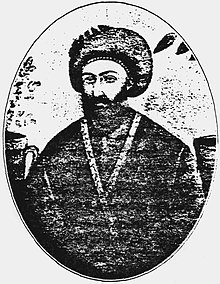Sayyid Kāzim Rashti
Sayyid Kāzim bin Qāsim al-Ḥusaynī ar-Rashti ( Arabic سيد كاظم بن قاسم الحسيني الرﺷتي), known as Sayyid Kāzim Rashti ( Persian سید کاظم رشتي), (* 1793 in Rasht , Persia ; † 1843 in Karbala , Ottoman Empire ) was the son of Sayyid Qasim and was appointed leader of the Sheikhi by Sheikh Ahmad al-Ahsā'ī , the founder of Sheikhism .
Life
He came from a family of influential traders, acquired the title of mullah and told his students about the return of the Mahdi and the Messiah and taught them how to recognize him. He died in 1843 and was buried near the Imam Husain shrine in Karbala . After his death in 1843, many of his students went to Africa , Asia and Europe to look for the Mahdi. One of his disciples, Mulla Husayn , met Sayyid Ali Muhammad, later known as "the Bab " , in 1844 and saw him as the second coming of the Mahdi. With Mulla Husayn , many Sheikhis converted to Babism and the remaining split into three groups.
Individual evidence
- ↑ a b Nabíl-i-Zarandí: The Dawn-Breakers: Nabíl's Narrative . Bahá'í Publishing Trust, Wilmette, Illinois, USA 1932, ISBN 0-900125-22-5 , pp. 2 ( online ).
literature
- Abbas Amanat: Resurrection and Renewal . Cornell University Press, New York 1989, ISBN 0-8014-2098-9 .
- Hasan Balyuzi : The Báb: The Herald of the Day of Days . Ed .: George Ronald. Oxford 1973, ISBN 0-85398-048-9 .
- Edward Granville Browne : Bábism . 1889 ( online ).
- Munirih Khanum: Memoirs and Letters . Kalimat Press, Los Angeles 1987, ISBN 0-933770-51-0 ( online ).
- Nabil-i-Zarandi: The Dawn-Breakers: Nabíl's Narrative . Bahá'í Publishing Trust, Wilmette, Illinois 1932, ISBN 0-900125-22-5 ( online ).
| personal data | |
|---|---|
| SURNAME | Rashti, Sayyid Kāzim |
| ALTERNATIVE NAMES | Sayyid Kazim-i-Rashti; Kāẓim bin Qāsim al-Ḥusaynī ar-Rashtī |
| BRIEF DESCRIPTION | Leader of Sheikhism |
| DATE OF BIRTH | 1793 |
| PLACE OF BIRTH | Rash , Persia |
| DATE OF DEATH | 1843 |
| Place of death | Karbala , Ottoman Empire |
